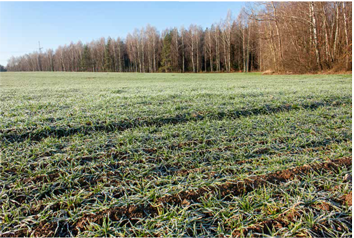Maximizing Your Cover Crop Potential
Click here to view as a pdf: Maximizing Your Cover Crop Potential
There are many benefits of incorporating a cover crop into crop rotations. Clearly identifying crop needs and goals will aid in proper plant species selection.
This article will discuss four basic goals of cover crops; protecting soil from erosion, grazing and harvesting of forage, improving soil health and weed suppression.
Protecting Soil From Erosion
In some situations, producers are not expecting to gain forage from planting a cover crop. The cover crop is planted strictly to protect soil from erosion until the main production crop is planted. This tactic can be used when planting corn or soybeans on erodible soils. After harvesting the main crop, a cover crop such as winter wheat (or other quick to establish plants) can be seeded to decrease soil erosion. Crops to consider:
- Cereal Grains killed by frost
- Annual Clover (nitrogen credits) and Grasses
Grazing And Harvesting For Forage
Grazing and harvesting a cover crop field can provide additional forage in late spring and early fall when grass quality is starting to dwindle. Allow enough time for the cover crop to have sufficient growth before grazing or harvesting. This may present a challenge in regions with a shorter growing season. Meadow Fescue is one crop that has been gaining in popularity because it does not have the negative endophytes that tall fescue has and still can withstand drought, freezing temperatures and grazing pressure very well. Planting the right mix will provide high quality and high yielding forage. Crops to consider:
- Cereal Grains (winter wheat or winter rye for spring grazing)
- Meadow Fescue
- Festulolium
Improving Soil Health
Over time, cover crops can help build up the organic matter level of the soil. Building organic matter can lead to an increase in nutrient and moisture holding capacity of the soil. Increasing nutrient holding capacity will help crops utilize fertilizers applied to fields by holding the nutrients in the root zone and preventing them from leaching. Planting legumes can fix nitrogen, increasing nitrogen credits for the next crop.
Planting turnips and radishes can help to break up soil compaction and build soil structure on heavy clay soils. Crops to consider:
- Legumes: Clover, Peas
- Turnips
- Radishes
Weed Suppression
Cover crops can provide weed suppression. When planted at high rates cover crops can crowd out weeds and canopy over any exposed soil. Cereals are a good choice for this. Certain cover crops like rye, produce chemicals that inhibit the growth of weeds. This process called allelopathy occurs when the cover crop is killed and the plant material is decomposing. The decomposing plant material acts like a pre-emergent herbicide, reducing the likelihood that weed seeds will germinate. Allow two weeks after cover crop kill before planting the next crop.2 Crops to consider:
- Rye
- Brassica
- Cereals Grains planted at a high rate
When selecting a cover crop, make sure to check what crops are best suited for the area and remember it is important to soil test before planting. A cover crop can greatly benefit soil health, soil structure and provide fertilizer credits, but the soil must first be able to support the growth of the cover crop. A basic soil test from Midwest Labs or Dairyland Labs can show the value of phosphorus and potassium in the field, as well as pH and soil type. This information can then be used to determine what cover crop to plant and if fertilizer is needed.
Consider time and field history before planting a cover crop. Every season is different and sometimes the weather can affect when it is possible to get into fields. Not being able to get crops off the fields at ideal times can impact what cover crops can be used. Always ensure the cover crop will have enough time to establish and grow to meet crop goals and that there is enough time to terminate the cover crop before planting the main crop. Look at field history. If herbicides have been used on the field, make sure to check that there is no carryover that will negatively impact the desired cover crop.
There are programs available for incorporating cover crops into your crop rotation. Working with a local extension agent can help you select the right cover crop to take advantage of these incentive-based programs. Always keep your nutritionist and agronomist informed of pending decisions as they can provide guidance for cover crop selection. To start a discussion about utilizing cover crops on your operation call a Crystal Creek® nutritionist today.


